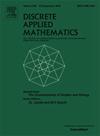关于异幻图的构造
IF 1
3区 数学
Q3 MATHEMATICS, APPLIED
引用次数: 0
摘要
一个2n阶的简单连通图被定义为n阶的xor-magic图,如果它的顶点可以用F2n中的向量以一对一的方式标记,使得每个顶点的闭邻集的标记之和等于零。本文介绍了一种自开关运算方法,当适当地应用于一个n次的奇数异幻图时,可以生成一个n+1次的异幻图。我们证明了任意给定奇数幻图的适当自交换操作的存在性,并在此过程中给出了连通图的切空间的表征。我们还观察到,通过应用三个连续的自切换操作,可以从4阶完全图得到Dyck图。此外,我们还研究了各种图积,包括笛卡尔积、张量积、强积、词典积和模积。我们观察到这些乘积允许我们通过选择适当的因子图来生成xor-magic图。值得注意的是,我们发现当图的模积因子的阶数是2的幂时(除了2本身),它总是一个xor-magic图。在这个过程中,我们认识到Clebsch图是循环图和空图的模积,每一个都是4阶的。通过将自交换运算与模积相结合,证明了对于所有n≥2和所有k∈{3,5,7,…,2n-5}∪{2n-1},存在k个n次方的正则xor-幻图。我们还证明了不存在n次的(2n-3)正则x -幻图。最后,我们介绍了另外两种生成x -幻图的方法。一种方法利用凯利图,另一种方法利用线性代数。本文章由计算机程序翻译,如有差异,请以英文原文为准。
On the construction of xor-magic graphs
A simple connected graph of order is defined as a xor-magic graph of power if its vertices can be labeled with vectors from in a one-to-one manner such that the sum of labels in each closed neighborhood set of vertices equals zero. In this paper, we introduce a method called the self-switching operation, which, when properly applied to an odd xor-magic graph of power , generates a xor-magic graph of power . We demonstrate the existence of a proper self-switching operation for any given odd xor-magic graph and provide a characterization of the cut space of a connected graph in the process. We also observe that the Dyck graph can be obtained from the complete graph of order 4 by applying three successive self-switching operations. Additionally, we investigate various graph products, including Cartesian, tensor, strong, lexicographical, and modular products. We observe that these products allow us to generate xor-magic graphs by selecting appropriate factor graphs. Notably, we discover that a modular product of graphs is always a xor-magic graph when the orders of its factors are powers of 2 (except for 2 itself). In the process, we realize that the Clebsch graph is the modular product of the cycle graph and the empty graph, each of order 4. By combining the self-switching operation with the modular product, we establish the existence of -regular xor-magic graphs of power for all and for all . We also prove that there is no ()-regular xor-magic graph of power . Lastly, we introduce two more methods to produce xor-magic graphs. One method utilizes Cayley graphs and the other utilizes linear algebra.
求助全文
通过发布文献求助,成功后即可免费获取论文全文。
去求助
来源期刊

Discrete Applied Mathematics
数学-应用数学
CiteScore
2.30
自引率
9.10%
发文量
422
审稿时长
4.5 months
期刊介绍:
The aim of Discrete Applied Mathematics is to bring together research papers in different areas of algorithmic and applicable discrete mathematics as well as applications of combinatorial mathematics to informatics and various areas of science and technology. Contributions presented to the journal can be research papers, short notes, surveys, and possibly research problems. The "Communications" section will be devoted to the fastest possible publication of recent research results that are checked and recommended for publication by a member of the Editorial Board. The journal will also publish a limited number of book announcements as well as proceedings of conferences. These proceedings will be fully refereed and adhere to the normal standards of the journal.
Potential authors are advised to view the journal and the open calls-for-papers of special issues before submitting their manuscripts. Only high-quality, original work that is within the scope of the journal or the targeted special issue will be considered.
 求助内容:
求助内容: 应助结果提醒方式:
应助结果提醒方式:


